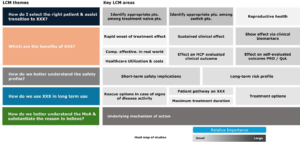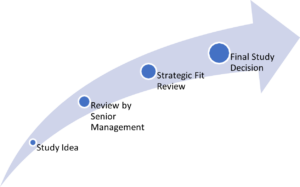Obtaining Strategic Fit for a Study Idea

The life cycle management (LCM) of a pharmaceutical product/technology is both resource and time intensive. There is therefore a need for an overarching strategic plan which is even more crucial for smaller companies working with limited resources. One aspect of this is the need to regularly re- assess the clinical development plan to identify emerging data gaps, while continuing to fulfil local rules and regulatory obligations and confirming its benefit/risk ratio.
The R-W-W (“real, win, worth it”) screen, originally developed by Dominick Schrello and popularised in a paper by George Day, is a powerful tool to evaluate individual projects. Versions of the screen have been circulating since the 1980s, and since then, a growing number of companies have used this disciplined, systematic process to assess business potential and risk exposure when considering new products.
The R-W-W screen is built on a series of questions about the product/technology, its potential market and competition, and the company’s capabilities. It is not an algorithm but, rather, a standardized process that can be employed at multiple stages of development to check assumptions, knowledge gaps and potential sources of risk.
The R-W-W screen highlights six fundamental questions: Is the market real? Is the product/technology real? Can it be competitive? Can the company be competitive? Will it be profitable at an acceptable risk? Does launching it make strategic sense? A definite no to any of questions should lead to termination of the project.
The real benefit of the process is that it questions the inevitable emotional aspect of strategic thinking where product development continues too long, with all the attendant waste of time and resources, before a decision to call it a day is made.
For example, the robustness of a market is almost always less certain than it first appears; a lack of strong proof-of-concept evidence needed to test and demonstrate an idea, or, the funding to prove it can be difficult to obtain; the more unusual or unexpected the idea is, the harder the work is required to show that the demand is there or that the market is willing to pay for it.
As the product or technology moves through its life cycle, data gaps need to be refined through repeated regular review. These are identified by questioning key stakeholders about clinical practice and safety concerns, reviewing the therapeutic and competitive landscape, and horizon scanning to inform on strategic shift and to ensure a competitive advantage. Using this information, a heat map can be built up to address specific themes associated with key areas of development. Within each theme, particular areas that need further study can be highlighted according to relative importance by using a darker colour in the heat map. An example of this is shown below.

While there are obviously some studies that are required for regulatory purposes prior to obtaining a marketing licence, new ideas for studies, particularly once the product is in Phase III/IV, will need to be considered. These may come from inside the company or from external sources. Internal ideas may seek to answer questions, for example, about reimbursement, while from outside might be about potential new uses or applications. Whatever the source, any new study idea should be reviewed in the light of the overall strategic plan for the product and how it could answer the questions in the R-W-W screen.
Before going forward for strategic fit approval, all study ideas should obtain initial endorsement for development by senior management.

Prior to submission for strategic fit, a study idea must be aligned with the company’s LCM research priorities and fulfil prerequisites such as accuracy and completeness, operational feasibility, or regulatory compliance. In particular, the rationale, objectives and endpoints should be clearly defined, the patient population sufficiently described in terms of inclusion/exclusion criteria, and the sample size discussed with a statistician. A template can be used to ensure that this stage is completed correctly. The template is then circulated to the cross-functional review team with a senior manager with strategic oversight and authority over each project’s development budgets and allocations typically taking the lead. The team members assess each idea independently and meet physically or electronically to discuss reasons for any differences of opinion and arrive at a consensus.
In the earlier stages of product/technology development there is a need to seek to identify questions that are applicable throughout the entire life cycle such as appropriate dosage, administration, or endpoints for investigational drugs. In later stages questions may focus on recognizing differences between similar or in-class products/technologies or look at other matters such as reimbursement, new applications or patient populations or even new biomarkers.
The Strategic Fit Team will assess whether a Study Idea is In Scope or Out of Scope. They will grant approval for the idea to proceed to full development. Because this is such an important milestone, the minutes from the meetings should specify the attendees, the proponents of the attached study idea, comments received, actions taken, and final study decision.
There are several reasons why a study proposal can be out of scope but duplication, major overlapping, off-label, or non-alignment with the developer’s priorities are the most frequent. One way of avoiding the more common reasons for refusal is to use a study tracker, which may be a simple spreadsheet available to all internal proponents, to check for possible duplication or other reasons why the study idea should not be going ahead before submission for strategic fit.
The study tracker can be further developed as a central repository of all planned and ongoing studies and provides key details about the status and activities from inception to publication. It allows to scrutinize the activities, including site and patient recruitment, estimated timelines, and any potential emerging issues, to generate ad-hoc reports, and to provide guidance on when data packages will be available for publication. It can also be used to promote collaboration between local teams with insufficient resources to participate in multi-country studies
The study tracker should be updated in real-time and searchable by the local teams to provide up-to- date information, overviews for management, publication planning and other purposes.
In summary, a careful reality checks on the product/technology should be done repeatedly throughout a product’s lifecycle and any data gaps should be actively sought through questioning key stakeholders with systematic and regular surveys.
New ideas for studies should be considered in the light of the overall strategy for the product and screened.
When considering a new study idea, it should be reviewed by a cross-functional team familiar with the development status, and the condition to be investigated for Strategic Fit designation. It is important that the approval or rejection for full study execution should be fully documented, and the progress of every study idea monitored in a product-specific study tracker until completion.
To answer current and future questions regarding the product’s profile and its relative positioning compared to competitors in terms of its adoption and usage by HCPs, patient compliance, and payer reimbursement, the Strategic Fit Screen can help to ensure that the right data are collected at the right time to maximize the potential of the product or technology.
Day GS. Is it real? Can we win? Is it worth doing? Managing risk and reward in an innova on por olio. Harv Bus Rev. 2007 Dec;85(12):110-20, 146. PMID: 18283921.
|
To get free access to our interesting schedule of publications and events, please join our Community here.